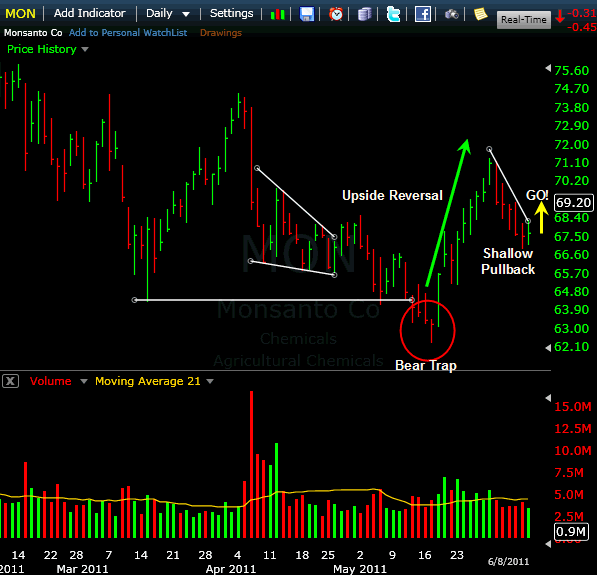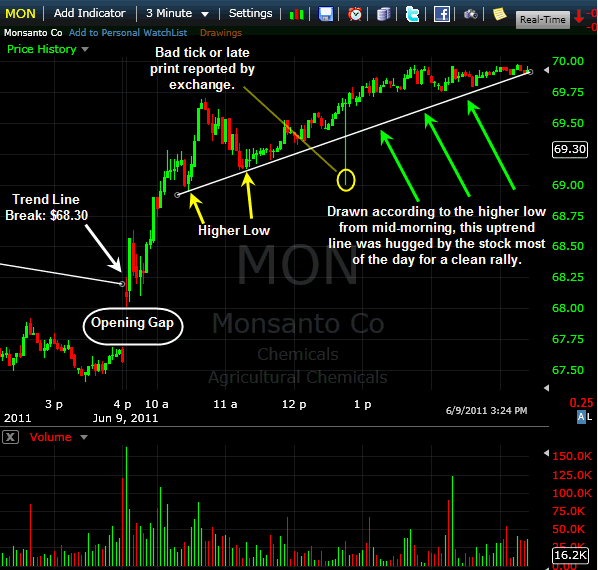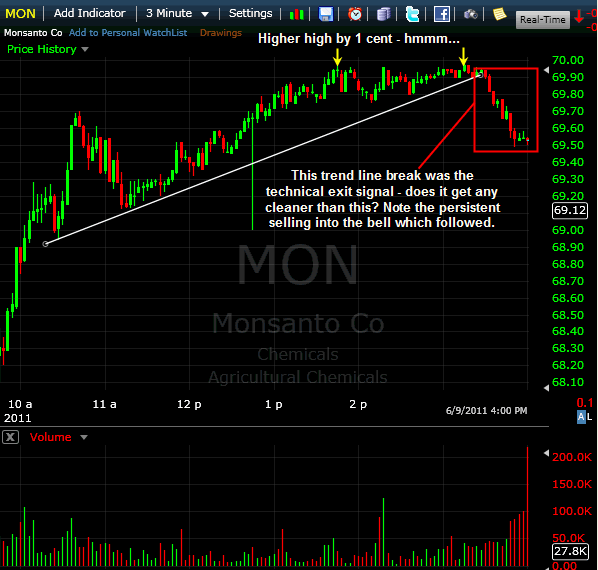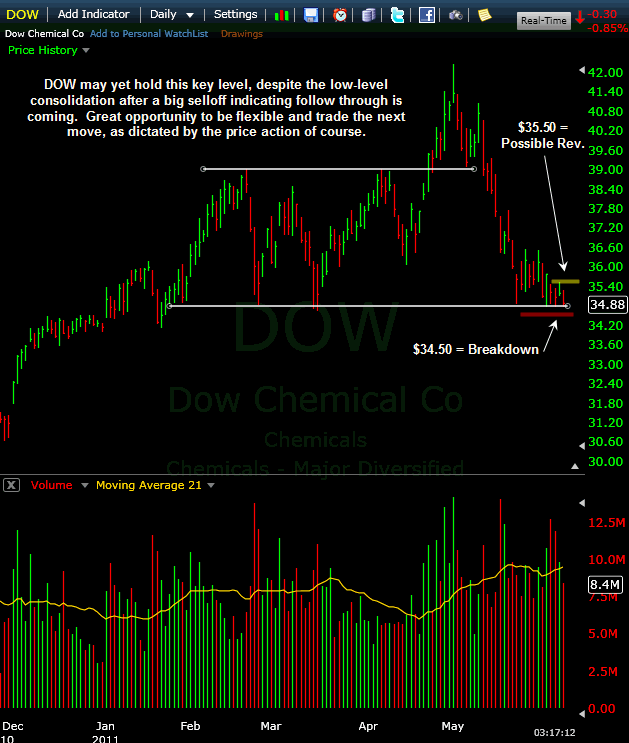 Archive for June, 2011
Archive for June, 2011
YOUR Trading Plan, Part 3
June 15, 2011 at 7:52 am
 In Part 1 we discussed the importance of discovering YOU. In Part 2, we looked at the need for defining risk so that you know “the number” for every trade you make.
In Part 1 we discussed the importance of discovering YOU. In Part 2, we looked at the need for defining risk so that you know “the number” for every trade you make.
Here in Part 3, let’s see what the remaining process might look like.
Playing Favorites
In accordance with what you’ve already discovered about yourself, the first step in the next phase is to identify 3-5 patterns you’re comfortable trading. This chart pattern page is a great starting point. Pick out a few you think you can locate with ease, and you can always build or add more later. The aim is to master a few plays which you can rely on, and then build more into your arsenal later.
Next, set up some watch lists for each of those patterns. Add stocks into the appropriate list (ex: ascending triangle candidates) and remove them when they fail to meet the designated criteria. Filter out low-priced stocks or thinly traded issues (I prefer to avoid stocks with daily average volume below 500,000 shares). This is just another way to narrow down your list. Draw trend lines when necessary, and make notes when you see important technical events unfolding. My stock newsletter highlights actionable ideas with identifiable patterns nightly which you may be seeking. But regardless of where you get ideas, the point here is to cultivate them on an ongoing basis.
At this point, it’s time to eliminate stocks which misbehave. These are stocks which gap frequently, or which tend to make sudden, adverse moves, or which have a history of breakout failures immediately after clearing resistance levels. Some stocks my either be too volatile or too sluggish for your liking, so get rid of them. It’s up to you, but by studying your lists closely on a regular basis, you’ll identify certain “personalities” which seem to jive better with you than others, and again this will narrow down your list by eliminating those which are not a fit.
All About Priorities
Finally, designate a way to prioritize plays. It might be the pattern itself (maybe you like ___ pattern better than ___ pattern). Or maybe it’s a certain price range preference (ex: you might like stocks in their $30’s better than single-digit stocks). It may be based upon the cleanness of the pattern – for me this is important. I like cleaner patterns, just because they are that much more concise on when I should be IN vs. OUT of the trade.
Whatever you choose, have a hierarchy for which plays you seem to do better with than others, as this will help you narrow down *your* trades without putting you into the first 25 stocks you see. It’ll also help you decide which plays to hold onto and which plays to rotate out of when you see a more fitting opportunity for your capital.
CONSISTENCY is the key. The actual selection you make isn’t nearly as crucial as many think. It’s more important to be decisive and pick one and manage it properly than it is to flip/flop between one strategy and another. The success comes in having a plan and putting it to work over and over through time, like a batter knowing he’ll have 1000 at-bats. You want to eliminate errors, and those largely come from indecision and inconsistency, like swinging at pitches outside of your hitting zone.
I hope this series has been helpful to you and has answered some lingering questions which pertain to your unique situation. There IS a trading style for you, but you have to ask the right questions, put the right kinds of plays into your routine, and then consistently execute the plan you’ve set forth.
Should you need additional coaching or assistance for your trading, contact me and I’ll be glad to show you several solutions.
Trade Like a Bandit!
Jeff White
Producer of The Bandit Broadcast
YOUR Trading Plan, Part 2
June 14, 2011 at 9:36 am
 In Part 1, I put forth some questions that need to be answered by you in order to move forward with any lasting effect. Those help you identify what it is you’re after, what styles you should pursue, and which approaches you should completely avoid. Let’s proceed.
In Part 1, I put forth some questions that need to be answered by you in order to move forward with any lasting effect. Those help you identify what it is you’re after, what styles you should pursue, and which approaches you should completely avoid. Let’s proceed.
Start With the Basics
Understanding your preferences, biases, needs and availabilities will clarify your basic approach.
For example, if you were trading a retirement account (non-margin, and thus no short selling, and you prefer the long side and capturing segments of uptrends, you’ve got a starting point. You might narrow your focus to a long-only style based on patterns such as resistance breakouts, as well as bullish continuation patterns like bull flags, bull pennants, and ascending triangles. Those are easily identifiable patterns, which is nice, so you should have a steady flow of candidates to suit your needs.
See what I meant in Part 1 when I said trading allows you a custom-designed approach?
Go Big AND Go Home
Next, decide on a risk amount per trade, in terms of potential dollar loss – not in terms of cash outlay. Think in terms of “real risk” or what you’re truly risking before exiting on the downside. This is the amount you’re willing to lose if/when you are wrong.
That sounds negative, but it’s crucial. Whether it’s $200 or $500 or $5,000 doesn’t matter, so long as it’s a suitable amount of risk for your unique situation. The amount itself is of secondary importance to simply having an amount. It’s a starting point for every trade.
Too many traders fail to begin with an amount of risk they can stomach, and they trade too big and pay the price. That’s no good, so always aim to trade within your means so you can survive and make good decisions.
For example, let’s say your risk amount is $200 per trade. This is what you’re willing and able to risk (lose) if the play doesn’t work out.
So take a trade in XYZ with a pattern that suits you, like an ascending triangle pattern. A breakout might be at $18, and a failure might be at $16. So you could go long this hypothetical trade at $18 with a $16 stop. That’s a $2 per share stop, and you’ll risk $200 per trade, so you could buy 100 shares. Easy math. It doesn’t have to be complicated to be helpful to your trading.
See how knowing *the number* for you can help you understand how much to be trading? The strategy itself is based on the pattern confirmation (entry) or failure (stop loss), but your position size comes down to what you’ll risk per trade. Few traders incorporate this into their plan, but if they did, they’d be miles ahead and avoid many painful trading disasters as well.
In part 3, I’ll wrap this up with some specifics for your overall process. Until then, decide on some basics which suit you and figure out your ‘number.’
Trade Like a Bandit!
Jeff White
Producer of The Bandit Broadcast
YOUR Trading Plan, Part 1
June 13, 2011 at 12:42 pm
 You are unique (and you don’t need me to tell you that). The desire to find a trading plan that’s right for YOU is of paramount importance, because we are all a little different.
You are unique (and you don’t need me to tell you that). The desire to find a trading plan that’s right for YOU is of paramount importance, because we are all a little different.
When it comes to your chosen trading methodology, you need to determine a number of things about yourself before going forward. These are things like your trading timeframe, risk tolerance, directional bias, and desired setups to pursue.
That’s the beauty of trading, you know. The market offers you the ability to custom-design an approach that works for YOU. Ask yourself questions such as…
* Will you be day trading for smaller but more frequent profits, or will you be entering positions for several days or weeks?
* Will you be comfortable keeping tight stops of just a few percent, or are you comfortable allowing more breathing room for trades in order to reach a more distant profit objective?
* Are you comfortable short selling, or do you prefer to only buy stocks?
* Are there specific patterns which you really like to trade or have found success with, such as buying dips within uptrends or perhaps buying breakouts?
These kinds of questions which can only be answered by you, but you MUST determine those answers in order to be effective. Those answers are paramount to your finding the proper strategy for YOU. I cannot emphasize that enough. Otherwise, you’ll be chasing different strategies by the day, but never knowing what’s working best and what to completely avoid. And if you’re dabbling in strategies which don’t suit you, you will not trust them or commit to them.
So when it comes to your trading plan, the more clear you can be on who you are, the more clearly you can define what it is you should be trading – and (equally important) what you should NOT be trading. That last part gets many traders in trouble, they stray into unfamiliar territory and find themselves making poor decisions which prove costly.
Since this is Part 1, there’s obviously more to come. But before the next part arrives, you have some homework to do – answer those questions above. I don’t want to know the answers to them, but you’re going to need them. Otherwise, the info to follow will carry no significance to you, rendering your time (and mine) completely wasted. Don’t be “that guy!”
I’ll see you in Part 2.
Trade Like a Bandit!
Jeff White
Producer of The Bandit Broadcast
MON Day Trade Review
June 10, 2011 at 10:13 am
Lately I’ve not trusted the price action much when it comes to swing trading, and that’s largely a product of how this market has been moving. Just a couple of weeks ago we saw a late-May ramp which produced trend line breaks for several of the indexes. However, that move was quickly erased, and the market continues to correct as I type.
The sharp rally and turn-on-a-dime reversal to the downside of the past couple weeks negated most bullish patterns which were building in the charts of individual stocks, and the nonstop selloff since then has taken with it anything which looked remotely bearish. Clearly, there just hasn’t been much in the way of high-quality bases and the kinds of clean patterns I really prefer to see when swing trading.
My preference is to swing trade for overall account growth, and day trade to create cash flow. Operating on multiple timeframes allows me to not only maximize the use of my capital, but also to benefit from directional moves which don’t even have to be correlated. I may be short on a swing basis to participate in a multi-day correction, but there will be intraday bounces along the way which are worth day trading. That kind of approach works best for me, and forces me to not only stay aware of current conditions but also to keep an open mind for what could happen next.
So with little available in the way of swing setups in recent days, I’ve focused on day trading. I wanted to walk you through one of yesterday’s trades (highlighted in Wednesday’s Broadcast) and show you how finding a setup on the daily chart and then managing it via the intraday chart can benefit you.
The Setup
MON broke support in mid-May, but it proved to be a headfake and the stock turned sharply higher and tacked on a quick 10%. It pulled back early this month (along with the market), yet showed some nice relative strength by giving back only a portion of the previous move. There also was a clean descending trend line, which happened to be rather steep, marking the pace of the pullback. That offered a well-defined pivot for getting long, so I used $68.30 as my trigger for a long entry on Thursday. Here’s the setup:
The stock cleared the trend line shortly after the open on Thursday, pushing past $68.30. About an hour later, it pulled back, but held above the prior intraday low (noted below). From there, it started to creep back up, allowing me to draw a very clean uptrend line which I then used as my get-out signal. Here’s the intraday chart:
Late in the session, that uptrend line was broken to provide a technical exit and the stock slid lower into the closing bell as traders rushed to lock in profits. Here’s the chart showing the late-day break:
Takeaways from the Trade
Risk/Reward – As per my day trading strategy, my standard risk for day trades begins at 1% and is adjusted for volatility in the stock. This one required no special treatment, giving me an initial stop of 1%. As the stock trended higher in the opening hour, it made sense after a gap up open to expect that gap to hold, so I adjusted my stop to the low of the day (less than 0.5% –> even better!).
Intraday Trend – with the stock making regular higher lows intraday, it became clear that a change of that trend would warrant an exit. The emergence of a very clean uptrend line not only gave the stock a sustainable pace to rally, but also allowed for a well-defined, tight stop in case it were broken. I love finding setups on the daily chart and then trading them according to the intraday trend, and this is why.
Time of day – As the day progressed and the final hour arrived, MON made a new high by 1c as it cleared the previous high from 90 mins prior. Headfake. That break produced no follow through, which indicated that the high-level consolidation was in fact more of a battle than a rest. That alerted me to the idea of a failure at resistance, which happened soon after. The well-defined uptrend line was not far from price, so once it was broken it was clear that this was the time to ring the register and call it a trade (which traders did en masse). Grabbing a pain-free $1.60 or 2.3% isn’t bad for a few hours.
Trade Like a Bandit!
Jeff White
Producer of The Bandit Broadcast
Trading Against Key Levels
June 9, 2011 at 8:17 am
Pattern traders, technicians, and active traders in general love to watch for key levels. To some, it’s obvious to expect a reversal if that level is reached, while others expect a break.
Both sides have their case, and frankly, that’s what makes a market!
Today I wanted to point out an example of a stock I’ve been watching which has yet to do either. A key level – which has been tested multiple times not only in recent months but also in recent days – is the focal point right now, and one way or another I think there’s going to be a play. Here’s the setup:
DOW is clearly not in great shape here, as we’ve seen a steady slide from the May highs with every little bounce attempt getting sold. Plenty of distribution too as volume has spiked numerous times on recent selloffs. For the past 2+ weeks, the stock has lingered right near key support, looking like it could crack any day.
And yet it hasn’t.
The market overall has been very weak. The stock itself has yet to bounce, but it’s also ignoring a textbook breakdown opportunity here to really crack. And that has my attention.
At the start of this post, I mentioned how some traders are predisposed to watch for reversals and others watch for breakouts/breakdowns. I’m in the latter camp most of the time, and especially when the stock is consolidating against that level. DOW has been on my watch list for a breakdown in recent days, but I have yet to take an entry (since it hasn’t happened yet).
Currently, with the market oversold and this stock hanging tough like a NKOTB, I’m now open to a trade in the other direction (upside reversal). Isn’t that one of the huge advantages of trading the market? It’s like putting money on a horse when it’s running the back stretch, well after the race has started. The willingness to switch directions or modify (or reverse) an opinion is something flexible traders must have. This is one of those chances.
How I’ll approach this one is to use $35.50 (multi-day high) as a pivot for getting long, and $34.50 (breakdown) as a pivot for going short.
Trade Like a Bandit!
Jeff White
Producer of The Bandit Broadcast
7 Steps to a Trading Breakthrough
June 8, 2011 at 11:00 am
Breakthrough was a TV mini-series which aired last summer, and a good one – at least I thought. It got cancelled after just a couple of episodes, before its time of course! (Archived on Hulu though, in case you want to see it.)
The premise of the show was that ordinary people face real, painful challenges. The subjects on the show wanted help to overcome them or learn to live with those issues. Obstacles stood in the way between them and living the life they’ve dreamed of, so it was inspiring to see them get out of their comfort zone and face them head-on.
Self-help guru Tony Robbins was the coach. Think Biggest Loser, only these people were looking to lose their fixation on their problems, and he was the one to guide them through that process. Along the way, he showed why his reputation is so good through the work he did.
Robbins offered 7 guidelines for “breaking through” and they’re listed in bold below. I’ve added my own thoughts as they pertain to trading, so here we go…
1. Change your environment. If you want to make a change, the best way to start is by getting away from the norm to not only evaluate your current approach, but to design a new one. Mix it up. Get away from your desk, go to the park, take a walk…do anything but stay in front of your screens. Similarly, if you’re not trading well or seeing the market clearly, stop doing the same things! Perhaps it’s a timeframe shift you need to make (day vs. swing), or the places you’re getting ideas. Something in your routine is stale and you need to take a fresh approach.
2. Confront your real issues. It’s SO easy to blame anything and anyone but yourself. But that’s what losers do, and none of us want to be losers. If you’ve got a discipline issue, then get real about it. Grow up. If you’re simply lacking skills, then improve them. But don’t place blame elsewhere (my family distracts me, this market is too erratic, I need that other trading platform, etc.), because that will only perpetuate your dissatisfaction. Be big enough to face up to the underlying problem, and only then will you overcome it.
 3. Expand your limits. This is about discovering your inner strength in a new way. It’s about doing, not just telling yourself something. Take on a challenge that has nothing to do with trading. Skydive or climb a mountain or commit to losing 15 pounds or learn to waterski – something that you can do or achieve in a relatively short amount of time order to show yourself that when you put your mind to something, you can make it happen. It’s a step toward confidence, which will carry over into your trading. Doesn’t matter what it is, because your mind is directing each endeavor and you’re redefining what’s possible.
3. Expand your limits. This is about discovering your inner strength in a new way. It’s about doing, not just telling yourself something. Take on a challenge that has nothing to do with trading. Skydive or climb a mountain or commit to losing 15 pounds or learn to waterski – something that you can do or achieve in a relatively short amount of time order to show yourself that when you put your mind to something, you can make it happen. It’s a step toward confidence, which will carry over into your trading. Doesn’t matter what it is, because your mind is directing each endeavor and you’re redefining what’s possible.
4. Change your perspective. I remember after my first 2 years of trading on my own I walked into a daytrading firm. I saw 2 guys that day (my age) who had made $40,000 for the day. That gave me a whole new perspective, needless to say. Whatever you think you know, you are still oblivious to so much more. Investigate some other avenues for your trading, and it will shift your mindset permanently – and probably for the better.
5. Own the lesson. Many of us pay the tuition, but we don’t always remember the lesson. In the bigger picture for your trading, this step is about taking responsibility in order to create a lasting change. You’re maturing in your approach, so take the parts of the past which can aid you and stamp them on your memory. You won’t be perfect going forward, but you’re now clear on what you need to avoid and that’s something you weren’t doing before step 2. Take the constructive pieces of the past and use them to your benefit.
6. Design a compelling future. Now that you’ve confronted your real issues and shown yourself what’s possible and you’re taking responsibility, it’s time to let go of the parts of your past which are holding you back and start looking forward. The beauty of trading (or one of them at least) is that the sky literally is the limit. Anything is possible, and yet too often we get caught in a rut and forget that. Getting away (step 1) is very helpful in this aspect, as it allows you to remember that you need not limit yourself in what it is you’re after. It doesn’t mean you start trying to hit homeruns instead of singles, but rather that you remember those singles can put you in the hall of fame!
7. Own your breakthrough. Anytime you grow, anytime you overcome an obstacle, anytime you confront what’s holding you back, it’s going to stay with you. Owning your breakthrough is about remembering where you’ve been in your trading, and building on it. You catapult yourself to a new level because of the growth you’ve experienced. Don’t forget where you’ve been, but place your focus on where you’re going. You won’t be free from frustration forever, but you’re on your way to a lasting breakthrough.
Trade Like a Bandit!
Jeff White
Producer of The Bandit Broadcast
Exploit Your Edge
June 7, 2011 at 12:55 pm
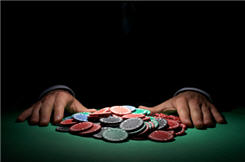 It’s a phrase many of us are familiar with as traders…”exploit your edge.” Sounds kinda like a cross between something illegal and something exciting, right?
It’s a phrase many of us are familiar with as traders…”exploit your edge.” Sounds kinda like a cross between something illegal and something exciting, right?
At the heart of the phrase though, is simply the idea of finding something that works in your trading, and then using it repeatedly to profit over time.
Poker professionals do it, and they can calculate with precision what their odds of winning a hand will be based on the cards they’re holding. That ‘data’ helps them make critical decisions on whether to fold or bet. Acting appropriately on their ‘edge’ will serve to not only keep them at the table, but help them win.
 Professional traders aren’t any different – only the scene is. Traders must also know their edge and use it in their decision-making process on a daily basis. Hold or fold? Lighten and tighten? Add to the position? It all depends, but it’s no guessing game for a veteran trader.
Professional traders aren’t any different – only the scene is. Traders must also know their edge and use it in their decision-making process on a daily basis. Hold or fold? Lighten and tighten? Add to the position? It all depends, but it’s no guessing game for a veteran trader.
Amateurs, by contrast, fail to recognize this. They pay for it, too. Operating on hunches, rumors, and generally utilizing the buy-and-hope “strategy” might occasionally result in some winning trades, but confusion and frustration are the most common effects. Amateurs don’t understand what their edge is, and therefore don’t know how to exploit it to their benefit.
The Proof is in the Profits
I’m big on evaluating trading performance in order to see what can be learned. Sometimes it’s something new, other times it might simply be a reminder of an important lesson.
Periodically on the premium site, the Recent Stock Picks page gets updated to reflect all swing trades and the corresponding stats which go with them. It’s nice to learn from those updates when they occur, specifically for the real value I get from the data provided. Here are a few of those lessons/reminders…
You don’t have to ‘win big’ to win big.
Too often, traders think they need to hit home runs in order to come out on top. Matter of fact, some of them are right, but it’s only because they need to overcome some enormous losses.
The truth is that in trading, hitting singles and occasional doubles can put you in the proverbial ‘Hall of Fame’ as those gains add up consistently. It’s not necessarily easy, but it is pretty simple and far more feasible than trying to nail down the rare home run. Just exploit your edge and watch your profits stack up…you’ll be amazed at what it turns into.
Small losses are crucial.
As I’ve noted here before, amateurs allow their losses to become too large. But what’s really interesting here is that it isn’t because they’re wrong more often. They’re simply wrong bigger.
Amateurs don’t lose small. That’s a grave mistake in this game, and you can’t afford it if you want to last and profit consistently as a trader. Set up some trading rules if you need to, or put a safety net in place, but for goodness sake, just stop it! When you know you’re wrong, exit and look for a new entry. It’s money you’re trying to gain here, not pride.
Streaks happen.
There’s no getting around it – at times you’re going to be red hot and other times you’re ice cold. Personally, there have been stretches where I took hit after hit, simply being out of sync with the price action, but there have also been times when I consistently turned profits.
Every single trader encounters that – pros and amateurs alike – but what matters most is how it’s handled. The amateur fights harder, increases frequency and size, and hopes that just a couple trades will make it all back.
The pro takes a different approach. When I found myself in a funk, I reduced my size accordingly, became more selective, and remained patient. Soon enough, I found myself back in sync with the market’s rhythm, and I was back on track.
So, step up your game if need be, but figure out what your edge is. Only then will you maximize it to your advantage.
Trade Like a Bandit!
Jeff White
Producer of The Bandit Broadcast


